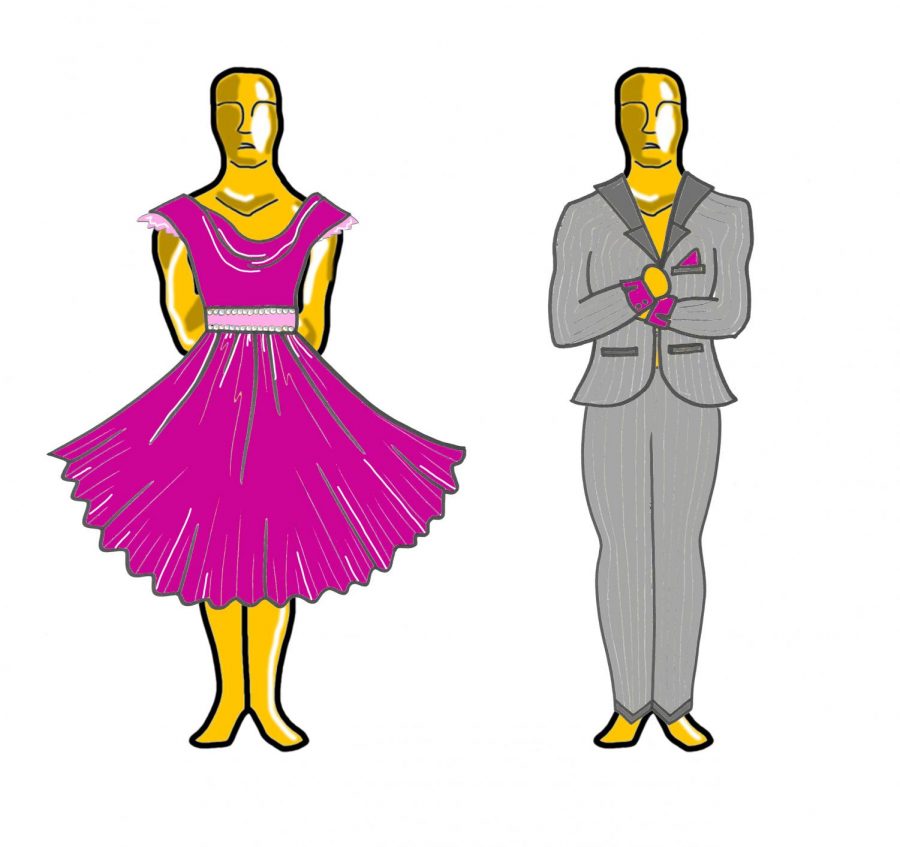Oscars Red Carpet Roundup
This year’s red-carpet looks acted as political statements, tributes, and purely aesthetic hits and misses.
February 11, 2020
With award season comes many highs and lows in fashion. At the 2020 Oscars, actors came to the red carpet dressed to impress. While some hit the mark, many also missed it. Many Fordham students have seen the movies that were nominated at the New York Film Festival in Lincoln Center. Movies like “Jojo Rabbit,” “1917,” “Little Women” and “Parasite” were shown at Lincoln Center.
Traditionally, having an interest in fashion has been associated primarily with women. Over the past year, we have seen people from all different backgrounds exploring fashion.
Spike Lee is an example of a director who used fashion and his platform to spread a message. Lee paid tribute to Kobe Bryant with a purple suit lined in gold with the number 24 written across the lapels. He paired the suit with purple glasses and hat to match. His outfit is more than clothing; it was meant to show respect.
Billy Porter has been a driving force in breaking barriers in men’s fashion. Porter has been fitted in clothing from tuxedos to dresses and everything in between. His looks have been in the eye of the press since last year. Porter’s stylist, Sam Ratelle, was recently recognized for his accomplishments regarding Porter’s style.
Fashion can be political, as many figures from politicians to actors have shown in the past. Natalie Portman came to the runway in a gold and black lace dress with a floor-length black cape to match. The cape had the names of all the female directors who were not nominated for an Oscar.
Though Porter has created a space where men can explore fashion, his 2020 Oscars look fell short. Designed by Giles Deacon, Porter wore a gold gown with a feathered bust and a ruched patterned skirt. Though the color suited Porter’s skin tone, the mix of feathers and large print was extremely distracting.
Trina Stewart, Fordham College at Lincoln Center (FCLC) ’23, thought that Porter’s look “has a lot going on. It works, though. My mom thought that it looked a gold peacock.”
Woody Wisz, FCLC ’23, didn’t love the outfit. He said, “Both patterns were good on their own; the overall appearance clashed a little unpleasantly.”
Showing up for their Best Picture-nominated movie “Little Women,” the cast hit the red carpet radiating with confidence, regardless of the clothing they were wearing.
Timothée Chalamet’s outfit sparked media attention. Chalamet’s Cartier navy blue two-piece tracksuit was underwhelming. People on Twitter said he looked like he worked at a gas station or was with the custodial staff.
Saoirse Ronan, on the other hand, was dressed beautifully in a Gucci layered gown sporting a light blue train paired with a white and black peplum. She surprised viewers of the Oscars with bangs, elevating her look further.
Olive Zoda, FCLC ’23, thought differently. She said, “The flow of the shape is interesting, but she looks like the inside of an oyster.”
Another honorable mention from the “Little Women” cast was Florence Pugh in a turquoise ruffled dress. The Louis Vuitton number was paired with matching shoes and a unique silver necklace. Pugh put her best foot forward, as she was nominated for Best Actress in a Supporting Role.
Billie Eilish is known for her oversized clothing by designers ranging from Gucci to Louis Vuttion and more. Eilish stepped onto the red carpet in head-to-toe Chanel. Though Eilish fans and fashion critics expected this look from her, she could definitely expand her fashion sense further.
“It’s cute. It’s more neutral colors than what she usually wears but a similar style. Nothing jumps out about this outfit, but her chains are really nice,” said Nisa Manzar, FCLC ’23.
There is power in award season and the trends that it brings. Actors can set the tone of who they want to be and the story they want to tell through clothing. In a city like New York that is surrounded by creativity, it’s important to remember the significance of our clothing. From who makes our clothes to how it was made, clothing creates a conversation of social change.












